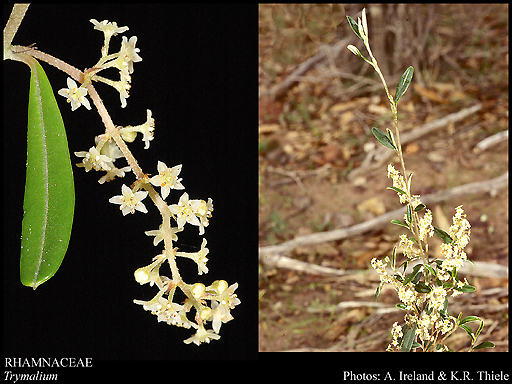- Reference
- Gen.Pl. [Jussieu] 376 (1789)
- Name Status
- Current

Scientific Description
Common name. Buckthorn Family.
Habit and leaf form. Trees, shrubs, and lianas, or herbs (Crumenaria). ‘Normal’ plants, or switch-plants; often with the principal photosynthesizing function transferred to stems. Leaves well developed, or much reduced. Self supporting, or climbing; climbers tendril climbers, or scrambling. Leptocaul. Mesophytic, or xerophytic. Leaves alternate, or opposite; when alternate, spiral; ‘herbaceous’, or membranous, or modified into spines; petiolate to sessile; non-sheathing; simple. Leaf blades entire; one-veined, or pinnately veined, or palmately veined; cross-venulate. Leaves with stipules, or without stipules. Stipules when present, intrapetiolar; free of one another; scaly, or spiny. Domatia recorded (4 genera); represented by pits, or pockets, or hair tufts. Stem anatomy. Nodes tri-lacunar. Secondary thickening developing from a conventional cambial ring.
Reproductive type, pollination. Fertile flowers hermaphrodite, or functionally male and functionally female, or functionally male, or hermaphrodite, functionally male, and functionally female. Unisexual flowers present, or absent. Plants hermaphrodite, or monoecious, or androdioecious, or polygamomonoecious. Entomophilous.
Inflorescence and flower features. Flowers solitary, or aggregated in ‘inflorescences’; in cymes, in corymbs, and in panicles. The terminal inflorescence unit cymose. Inflorescences terminal, or axillary; cymes, thyrses, corymbs or fascicles. Flowers small; regular; (4–)5 merous; cyclic; tetracyclic, or pentacyclic. Floral receptacle when free, markedly hollowed. Free hypanthium present (whether ovary superior or inferior). Hypogynous disk present (when stamens hypogynous). Perianth with distinct calyx and corolla, or sepaline (the corolla sometimes lacking); 5, or 8, or 10; 2 -whorled (usually), or 1 -whorled; isomerous. Calyx (4–)5; 1 -whorled; polysepalous, or gamosepalous; valvate; regular. Corolla (4–)5 (often small); 1 -whorled; polypetalous; induplicate valvate; regular. Petals clawed (often), or sessile. Fertile stamens present, or absent (female flowers). Androecium (4–)5. Androecial members free of the perianth (inserted at the mouth of the hypanthium), or adnate (then the filaments adnate to the corolla); free of one another; 1 -whorled. Androecium exclusively of fertile stamens. Stamens (4–)5; isomerous with the perianth; alternisepalous (and usually hooded by the petals, at least when young). Anthers dorsifixed; versatile; dehiscing via longitudinal slits, or dehiscing by longitudinal valves; introrse. Pollen shed as single grains. Fertile gynoecium present, or absent (male flowers). Gynoecium (2–)5 carpelled. The pistil (2–)3(–5) celled, or 1 celled. Carpels isomerous with the perianth, or reduced in number relative to the perianth. Gynoecium syncarpous; synovarious to synstylovarious; superior to inferior. Ovary unilocular, or plurilocular; (2–)3(–5) locular, or 1 locular (by abortion). Epigynous disk usually present (when ovary inferior). Gynoecium stylate. Styles 1 (deeply cleft); apical. Stigmas (2–)5; dry type; papillate; Group II type. Placentation when unilocular, basal; when plurilocular, basal. Ovules in the single cavity when unilocular, 1; when 2–5 locular, 1(–2) per locule; funicled to sessile; ascending; epitropous; when paired, collateral; arillate, or non-arillate; anatropous.
Fruit and seed features. Fruit fleshy, or non-fleshy; indehiscent, or a schizocarp; when non-schizocarpic, a drupe, or a nut; sometimes elastically dehiscent. Dispersal unit the mericarp, or the fruit (the latter often specially adapted to wind carriage). Seeds endospermic (thinly), or non-endospermic. Endosperm ruminate (Reynosia), or not ruminate. Embryo well differentiated. Cotyledons 2. Embryo chlorophyllous (4/6); straight. Seedling. Germination phanerocotylar, or cryptocotylar.
Physiology, biochemistry. Nitrogen-fixing root nodules present (with actinomycetes, in Ceanothus), or absent. Aluminium accumulation not found. Photosynthetic pathway: C3.
Geography, cytology, number of species. World distribution: cosmopolitan, except frigid regions. X = (9-)12/13(-23). 900 species.
Economic uses, etc. Edible drupes from Ziziphus spp. (jujube, Chinese date, ber or bor). Purgative (cascara sagrada) from Rhamnus purshiana.